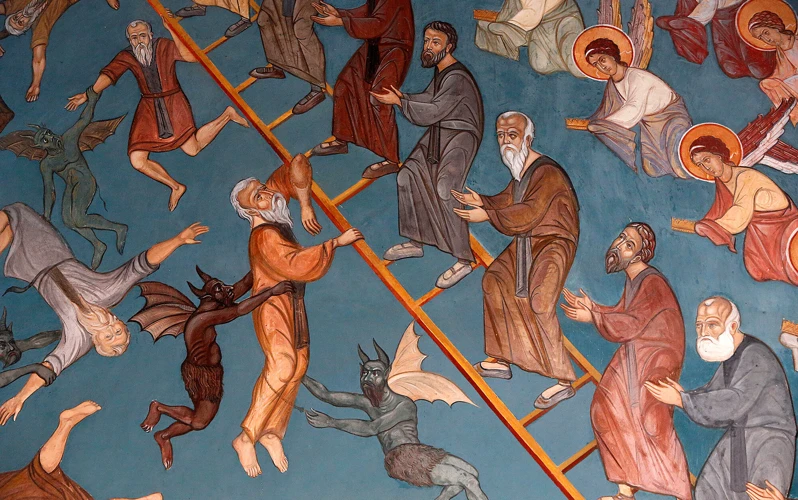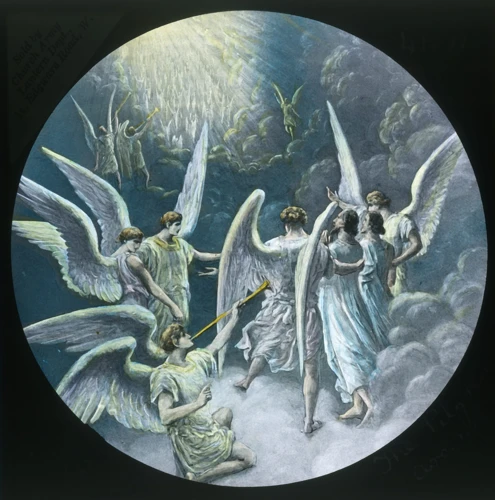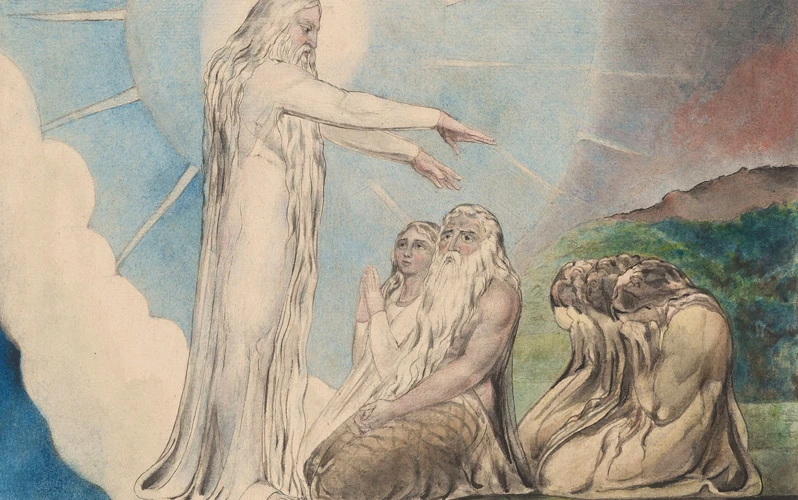As humans, we often wonder what lies beyond this physical world we live in – what exists in the realm beyond our senses? The concept of heavenly realms has long been explored in religious and spiritual beliefs throughout history. The Bible, in particular, contains numerous depictions and descriptions of the heavenly realms. In this article, we will explore these accounts step-by-step, beginning with the first mention in the Bible and how it evolved throughout the Old and New Testaments. We will also delve into the symbolism and imagery used in these depictions and attempt to gain a deeper understanding of the spiritual realm. Join us on this journey of discovery and contemplation.
First Mention of Heavenly Realms in the Bible

The concept of the heavenly realms in the Bible is a fascinating topic, and its first mention in Scripture leaves readers with a sense of wonder and curiosity. Delving into this ancient text, we can explore the descriptions of what is beyond our physical realm and gain insight into the spiritual world. From Abraham’s Bosom to symbolisms in the Old Testament, there is much to discover about the richness of heavenly realms in biblical literature. Let us start our journey into the divine realms of the Bible with the first mention of this otherworldly concept.
Abraham’s Bosom and Sheol
In the Old Testament, the concept of the afterlife was not well developed, and there are few direct references to the heavenly realms. However, there are some passages that offer glimpses into what the afterlife might look like.
– Abraham’s Bosom: This term is found in the Gospel of Luke (16:19-31) and refers to a place of comfort and rest for the righteous dead. The story goes that a rich man and a poor beggar named Lazarus both died and were sent to different places. The rich man went to Hades, while Lazarus was carried by angels to Abraham’s bosom. The term “bosom” here is meant to convey a sense of closeness or intimacy, indicating that the righteous dead were in a place of honor and nearness to Abraham, the father of the Hebrews.
– Sheol: This is a Hebrew term that appears frequently in the Old Testament and refers to the underworld or the realm of the dead. It is typically portrayed as a dark and gloomy place, where the dead reside in shadowy existence. Sheol is often described as a place of silence and forgetfulness, where the dead do not praise God and are cut off from the living. However, there are some passages that suggest the possibility of redemption or release from Sheol, particularly for those who have been faithful to God.
The exact nature of Abraham’s Bosom and Sheol is a matter of debate among scholars, and different interpretations have been offered over the years. Nonetheless, these concepts offer a glimpse into the way that the ancient Hebrews may have conceived of the afterlife, and they remain an important part of biblical tradition.
Heavenly Realm Symbolism in the Old Testament
The Old Testament is filled with symbolism that describes the heavenly realm. One of the most commonly used symbols is a mountain. Mountains are often seen as the point where heaven and earth meet, making them a symbolic representation of the divine realm. In Exodus 19, Mount Sinai is described as the place where Moses received the Ten Commandments from God. Mount Zion is also referenced in several Psalms as the place where God dwells.
Another symbol used to describe the heavenly realm is a temple. The temple was seen as the place where God’s presence resided, and it was a physical representation of the heavenly realm on earth. In 1 Kings 6-7, King Solomon builds the Temple in Jerusalem, which becomes the center of Jewish worship. The temple was seen as the place where heaven and earth met, and where sacrifices were offered to appease God.
The Tabernacle is also used as a symbol for the heavenly realm in the Old Testament. The Tabernacle was a portable temple that the Israelites carried with them during their journey through the wilderness. It was seen as a physical representation of God’s presence among the Israelites. The Tabernacle was also seen as a symbol of the heavenly realm because it was a place where God’s presence resided.
Finally, cherubim and seraphim are often used as symbols of the heavenly realm. They are angelic beings that are described as having wings and being in the presence of God. In Isaiah 6, the prophet describes his vision of the seraphim who were crying out “holy, holy, holy” in the presence of God. In Ezekiel 10, cherubim are described as guarding the entrance to the heavenly temple.
The Old Testament provides a wealth of symbolic language to describe the heavenly realm. From mountains and temples to cherubim and seraphim, these symbols are used to help us understand the nature of God and His dwelling place.
Heavenly Realm Descriptions in the New Testament

As we move into the New Testament, the descriptions of heavenly realms become even more vivid and detailed. The writers of the New Testament draw upon the rich symbolism and imagery found in the Old Testament, but also provide new insights and revelations about the nature of heaven and its inhabitants. Let us delve into the scriptures with open minds and hearts, and explore the wonders of the heavenly realms revealed in the New Testament.
Paul’s Visit to the Third Heaven
In 2 Corinthians 12:2-4, Paul describes an experience in which he was “caught up to the third heaven” and saw “inexpressible things, things that no one is permitted to tell”. While the meaning of “third heaven” is subject to debate, many scholars believe it refers to the highest heaven, the dwelling place of God.
What exactly did Paul see in the third heaven? Naturally, there is no way to know with certainty because he was forbidden to reveal the details. However, some theories suggest that he may have seen the dwelling place of the angels or the heavenly court of God.
Despite this mystery, what is clear is that Paul’s experience in the third heaven was deeply impactful. He describes feeling “unspeakable words” and being humbled by the vision. Interestingly, Paul also mentions that he was given a “thorn in the flesh” to keep him from being too prideful about this experience.
So, what can we learn from Paul’s visit to the third heaven? Even though we may not fully understand the details, we can see that it was a powerful experience for Paul. It also teaches us that there is a spiritual realm beyond what we can physically see and experience. As Christians, we can take comfort in the knowledge that God and his heavenly kingdom are very real, even if we cannot fully comprehend them.
Heavenly Realms in the Book of Revelation
The Book of Revelation serves as a unique and complex account of heavenly realms. The writer, John of Patmos, describes various visions that offer insight into what the spiritual realm entails.
One of the most striking depictions is of the heavenly city, the New Jerusalem. It is described as a stunning city of gold and precious stones, with twelve gates protected by angels. In the center of the city is the throne of God, fully illumined by His glory.
Another striking symbol in Revelation is the white throne judgment scene. The image is of God’s throne of judgment, with the dead, great and small, standing before Him. The books are opened, and judgment is given according to what is written in those books.
John also observes a great battle in heaven between Michael and his angels and Satan and his angels. Michael and his angels are victorious, casting Satan and his angels out of heaven and to earth. This is seen as evidence of the unending battle between good and evil.
The holy temple is also depicted. It is described as being open and having the Ark of the Covenant within. This is significant because it represents the presence of God among His people.
All of these images represent different aspects of the heavenly realms and provide a glimpse into the spiritual realm that exists beyond our physical world. And, while some may still view the language of Revelation as a mystery, it serves as a reminder that the heavenly realms are indeed an intricate and complex reality.
Understanding the Spiritual Realm
As we explore the biblical depictions of the heavenly realms, it’s important to have a deeper understanding of the spiritual realm. The spiritual realm is often a subject of fascination and perplexity for many people, and understanding it requires an open mind and a willingness to look beyond our earthly perspectives. Through scripture, we can gain a greater understanding of the spiritual realm and its role in our lives. Let’s dive deeper into this topic and discover the secrets of the spiritual realm.
Heavenly Realms Compared to Earthly Realms
When discussing the heavenly realms, it’s important to understand how they compare to the earthly realms we are familiar with. Here are some key differences to consider:
- The heavenly realms are spiritual: While the earthly realm is physical and material, the heavenly realm is spiritual in nature. This means that the laws and rules that govern the physical world don’t necessarily apply in the spiritual realm.
- The heavenly realms are eternal: The earthly realm is subject to decay and eventually comes to an end. In contrast, the heavenly realms are eternal and unchanging.
- The heavenly realms are perfect: The earthly realm is marked by imperfection and sin. However, in the heavenly realms, there is no sin or imperfection, only perfection and holiness.
- The heavenly realms are inhabited by spiritual beings: While the earthly realm is inhabited by humans and animals, the heavenly realms are inhabited by spiritual beings such as angels and the presence of God himself.
- The heavenly realms are not confined by time or space: In the earthly realm, we are limited by time and space. However, in the spiritual realm, there is no such limitation. Time and space are different and somewhat irrelevant concepts in the heavenly realms.
It’s important to note that our understanding of the spiritual realm is limited by our human perspective and our physical existence in the earthly realm. We can only comprehend so much about the heavenly realms, and there is much that remains a mystery to us. However, the Bible provides us with glimpses into these heavenly realms and gives us insight into the nature of spiritual reality.
Greater Understanding of the Spiritual Realm
As we explore the Biblical depictions of the heavenly realms, one topic that requires greater understanding is the spiritual realm. The Bible presents the spiritual realm as a realm that cannot be seen with the naked eye, yet it is real and ever-present. In order to gain a better understanding of the spiritual realm, we can look to the teachings of the Bible.
Ephesians 6:12 reminds us that our struggle is not against flesh and blood, but against the rulers, against the authorities, against the powers of this dark world and against the spiritual forces of evil in the heavenly realms. In this verse, Paul teaches us that there are spiritual forces in the heavenly realms that are at work in our world.
1 Peter 5:8 also reminds us to be alert and of sober mind because our enemy the devil prowls around like a roaring lion looking for someone to devour. Here, Peter is warning us that there are spiritual forces at work in our lives, seeking to deceive and destroy us.
In order to gain a greater understanding of the spiritual realm, we must also remember that God is sovereign over all realms, including the spiritual realm. Psalm 103:19 says, “The Lord has established his throne in heaven, and his kingdom rules over all.” This verse reminds us that even though we may not fully understand the spiritual realm, we can trust that God is in control.
The book of Hebrews tells us that the word of God is sharper than any double-edged sword and that it penetrates even to dividing soul and spirit, joints and marrow (Hebrews 4:12). The Bible is our ultimate source of understanding when it comes to the spiritual realm.
In order to gain a greater understanding of the spiritual realm, we must also rely on the guidance of the Holy Spirit. First Corinthians 2:14 tells us that the person without the Spirit does not accept the things that come from the Spirit of God but considers them foolishness. This means that without the Holy Spirit, we cannot fully understand the things of the spiritual realm.
The spiritual realm is a complex and mysterious realm that requires a greater understanding. We must rely on the teachings of the Bible, the sovereignty of God, and the guidance of the Holy Spirit in order to gain this understanding.
Conclusion
After exploring the biblical depictions of the heavenly realms, it is clear that the spiritual realm is a complex and multifaceted aspect of the Christian faith. The Bible provides glimpses into this realm, but it is clear that we cannot fully comprehend it with our human understanding alone.
Through the stories of Abraham’s Bosom and Sheol, we see the first mentions of the spiritual realm in the Bible. The Old Testament uses symbolism to represent the heavenly realm, with the sky and stars often representing God’s domain.
However, it is the New Testament that provides more concrete descriptions of the spiritual realm. Paul’s visit to the third heaven and the vivid depictions in the Book of Revelation give us insight into what the heavenly realms may look like.
Yet, despite these descriptions, the spiritual realm remains a mystery. We cannot fully understand it with our limited understanding. However, we can continue to seek greater understanding through prayer, scripture, and spiritual practices.
In comparing the earthly and heavenly realms, we see that the spiritual realm operates on a different plane than our physical world. It is timeless and eternal, while our earthly existence has a beginning and an end. This understanding can help us to better comprehend the vastness of the spiritual realm, and our place within it.
In conclusion, while we may never fully grasp the complexities of the spiritual realm, it is a vital aspect of our faith. By continuing to explore and seek understanding, we can deepen our relationship with God and gain greater insight into his divine plan for us.
Frequently Asked Questions
What Does the Bible Say about the Heavenly Realms?
The Bible mentions the heavenly realms several times, including in the Old Testament and New Testament.
What is Abraham’s Bosom?
Abraham’s Bosom is a symbol of the righteous dead in Jewish and Christian history who are awaiting judgment.
What is Sheol?
Sheol is a Hebrew word in the Old Testament that describes the place where the dead go, it is also a symbol of the underworld.
What Does the Old Testament Say about the Heavenly Realms?
The Old Testament mentions heavenly realms through symbolic language or imagery, such as the mention of the “sons of God.”
What Does the New Testament Say about the Heavenly Realms?
The New Testament mentions the heavenly realms as an actual place where God is, and where believers go when they die.
What is the Third Heaven?
The Third Heaven is a term used in the New Testament to describe the highest heaven, where the throne of God is located.
What is the Book of Revelation?
The Book of Revelation is the last book in the New Testament, and it contains a lot of apocalyptic imagery and references to the heavenly realms.
How Do the Heavenly Realms Compare to Earthly Realms?
The heavenly realms are depicted as perfect or ideal versions of the earthly realm, and the contrast between them highlights the fallen nature of our world.
Can We Understand the Spiritual Realm?
While we can understand some things about the spiritual realm through the Bible and our relationship with God, there is much about it that remains a mystery.
What Can We Learn about God Through the Heavenly Realms?
The heavenly realms reveal God’s majesty, power, and goodness, and our understanding of them can deepen our relationship with Him.








